Swan
|
|
- For other uses, see Swan (disambiguation).
| Swans | ||||||||||||
|---|---|---|---|---|---|---|---|---|---|---|---|---|
 Mute Swan | ||||||||||||
| Scientific classification | ||||||||||||
| ||||||||||||
| Genera | ||||||||||||
|
Cygnus |
Swans are large water birds of the family Anatidae, which also includes geese and ducks. Swans are grouped with the closely related geese in the subfamily Anserinae.
Swans usually mate for life, though "divorce" does sometimes occur, particularly following nesting failure. The number of eggs in each clutch varies both within and among swan species, typically between 3-8 eggs.
Young swans are known as cygnets, from the Latin word for swan, cygnus. The male and female adults are known as cob and pen, though these terms are little used nowadays.
The Northern Hemisphere species of swan all have pure white plumage, but the Southern Hemisphere species are all patterned with various amounts of black. The Australian Black Swan (Cygnus atratus) is black all over except for the white flight feathers on its wings, and the South American Black-necked Swan has, as its name suggests, a black neck; finally, the Coscoroba Swan, also from southern South America, has black tips to the primary feathers.
The legs of all swans are dark blackish grey, except for the two South American species, which have pink legs. Bill colour varies rather more; the three far northern species have black bills with varying amounts of yellow, and all the others varyingly patterned red and black. The Mute Swan and Black-necked Swan have a curious lump at the base of the bill on the upper mandible.
| Contents [hide] |
Species of swan
Genus Cygnus
- Whooper Swan, Cygnus cygnus breeds in Iceland and subarctic Europe and Asia, migrating to temperate Europe and Asia in winter.
- Trumpeter Swan, Cygnus buccinator is a North American species very similar to the Whooper Swan (and sometimes treated as a race of it), which was hunted almost to extinction but has since recovered: it is one of the heaviest flying animals, at up to 17 kilograms (38 pounds).
- Tundra Swan, Cygnus columbianus is a relatively small swan which has two major subspecies (sometimes treated as a distinct species); as the name suggests, it breeds on the Arctic tundra, further north than other swans.
- Bewick's Swan, Cygnus columbianus bewickii is the Eurasian form which migrates from Arctic Russia to western Europe and eastern Asia (China, Japan) in winter. The reserves of the Royal Society for the Protection of Birds and of the Wildfowl and Wetlands Trust in Britain are important for Bewick's and Whooper Swans.
- Whistling Swan, Cygnus columbianus columbianus is the North American race, which is sometimes considered a separate species from Bewick's swan.
- Black Swan, Cygnus atratus of Australia, and introduced in New Zealand. The Black Swan is the official state emblem of Western Australia, and is also the symbol of the Sydney beachside suburb of Dee Why.
- Black-necked Swan, Cygnus melanocoryphus of South America, formerly Sthenelides melanocorypha.
- Mute Swan, Cygnus olor, is a common temperate Eurasian species, often semi-domesticated; descendants of domestic flocks are naturalized in the United States and elsewhere.
Genus Coscoroba
- Coscoroba Swan, Coscoroba coscoroba, also of South America
Swans and The UK
There is rich iconographic and literary evidence for Celtic bird-goddesses who took the form of swans. The Roman Caesar noted that the British tribes thought wild geese and swans "unlawful" to eat or kill. By Medieval times, though, swans were considered an edible form of poultry. Nowadays they are a protected species in many countries.
The noise a swan makes was uniquely known as a beable, but this word has fallen into disuse in all but a few parts of Britain. Both the Ancient Britons and the Anglo-Saxons believed that a swan's wings throbbed and sang with a human voice when they flew.
It is a common misunderstanding that all swans in England are the property of the Crown; and therefore to kill one is an act of treason. This urban legend has only a partial basis in truth; some Mute Swans are legally the Crown's property, but whilst killing one is likely to land a person in trouble, it is more likely to be for cruelty to animals than treachery.
Mating
SwansHeart.jpg
Swans mate for life and when mating can seemingly provide a picture of a lovers' heart.
See also
cy:Alarch da:Svane de:Schwäne es:Cisne fr:Cygne he:ברבור it:Cigno (Uccello) ja:ハクチョウ nl:Zwaan pl:Łabędź (ptak) pt:Cisne (ave) sl:Labod zh:天鹅属
